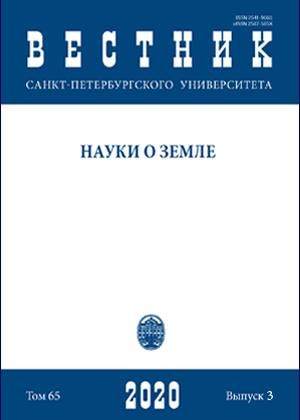Petrology of magmatic rocks of the Khara-Sis massif (Northern Verkhoyansk-Kolyma orogenic region)
DOI:
https://doi.org/10.21638/spbu07.2020.307Abstract
The article discusses the specific composition of igneous rocks of the Late Cretaceous monzonite-syenite-granite Khara-Sis massif, localized at the intersection of long-lived faults in the northeastern part of the Selennyakh anticlinorium. In most discriminatory diagrams, the points of monzonite and syenite compositions, on the one hand, and fluorite granites, on the other, set different trends, which indicates different sources of melts and different ways of their crystallization. Based on these data, typomorphism of rock-forming, accessory, and restite minerals, and the nature of the distribution of trace elements in the rocks, it is concluded that the massif is multi-formation. Monzonites and syenites correspond to post-orogenic formations of the shoshonite series and have mantle-crustal origin. The initial melt was formed at the specified temperature of 1050–1060 °C and a pressure of 1.7–1.9 GPA as a result of partial mixing of the lower crust melt and the melt inflowing from the horizons of the metasomatized mantle. Model Rb-Sr values of granites characterize them as crustal formations. According to all parameters of composition they belong to post-orogenic A-type granites. The disparity between high temperatures of the parent melt (1000–1025 °С), comparable to high temperatures of monzonite melt, at a significantly lower pressure of magma generation (0.7–0.8 GPA), indicates that granite was formed in the crust upon heat inflow from an outer (deep) source. All rocks of the massif have high contents of REE, Y, U and Th, increasing from monzonites to granites and are comparable with contents of REE, Y, U and Th only in the metasomatized mantle. It is concluded that deep fluids rich in these elements were supplied into crust substrates during the formation of the granite chamber, and an increase of the flow of deep substrates.
Keywords:
monzonite, syenite, granite, typomorphism of minerals, mantle-crust magma generation, crystallization, geochemical specialization
Downloads
Downloads
Additional Files
Published
How to Cite
Issue
Section
License
Articles of "Vestnik of Saint Petersburg University. Earth Sciences" are open access distributed under the terms of the License Agreement with Saint Petersburg State University, which permits to the authors unrestricted distribution and self-archiving free of charge.






